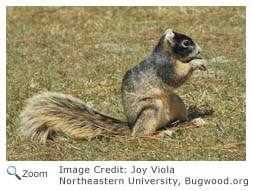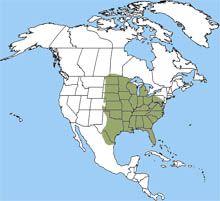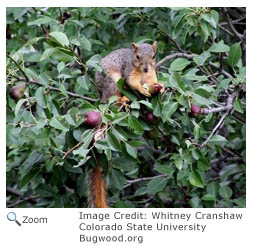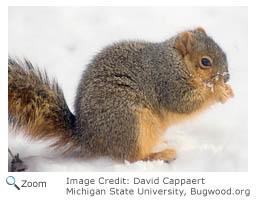Description
 The fox squirrel is the largest tree squirrel. It is 10-15 inches in length. It has three distinct color patterns. In the northeastern part of its range, it is gray above with yellowish undersides. In the western part of its range, it is gray above and rust colored on its undersides. In the southern part of its range, it is black and brown with a white stripe on its face and a white tip on its tail. The fox squirrel is also known as the eastern fox squirrel. The fox squirrel is the largest tree squirrel. It is 10-15 inches in length. It has three distinct color patterns. In the northeastern part of its range, it is gray above with yellowish undersides. In the western part of its range, it is gray above and rust colored on its undersides. In the southern part of its range, it is black and brown with a white stripe on its face and a white tip on its tail. The fox squirrel is also known as the eastern fox squirrel.
 A subspecies of the fox squirrel, the Delmarva fox squirrel (Sciurus niger cinereus), was once found in the Delmarva Peninsula, southeastern Pennsylvania, and southern New Jersey. It is now found on the eastern shore of Maryland and Virginia.
The Delmarva fox squirrel has a bushy tail and is gray with a white belly. A subspecies of the fox squirrel, the Delmarva fox squirrel (Sciurus niger cinereus), was once found in the Delmarva Peninsula, southeastern Pennsylvania, and southern New Jersey. It is now found on the eastern shore of Maryland and Virginia.
The Delmarva fox squirrel has a bushy tail and is gray with a white belly.
Range
 The fox squirrel is found in the eastern and central United States west to the Dakotas, Colorado, and Texas. It is not found in New England, most of New Jersey, western New York and northern and eastern Pennsylvania. Its range also extends into northern Mexico and southern Canada. The fox squirrel is found in the eastern and central United States west to the Dakotas, Colorado, and Texas. It is not found in New England, most of New Jersey, western New York and northern and eastern Pennsylvania. Its range also extends into northern Mexico and southern Canada.
Habitat
The fox squirrel lives deciduous and mixed forests. In the south, it is found in cypress and mangrove swamps.
|
|
|
Diet
 The fox squirrel eats acorns, hickory, walnut, beech, mulberry, and hawthorne seeds. It also eats green shoots and buds, fruits, berries, corn, insects, moths, and beetles. Nuts are stored for use in the winter. The fox squirrel locates its stashes using its keen sense of smell. The fox squirrel eats acorns, hickory, walnut, beech, mulberry, and hawthorne seeds. It also eats green shoots and buds, fruits, berries, corn, insects, moths, and beetles. Nuts are stored for use in the winter. The fox squirrel locates its stashes using its keen sense of smell.
Life Cycle
 The fox squirrel can mate at any time of the year, but mating usually reaches its peak in December and June. Usually, more than one male chases or follows a female. The successful male then protects the female from the other males. The female gives birth to a litter of two to four young 45 days after mating, usually in a nest in a hollow tree. She may have two litters a year. The fox squirrel can mate at any time of the year, but mating usually reaches its peak in December and June. Usually, more than one male chases or follows a female. The successful male then protects the female from the other males. The female gives birth to a litter of two to four young 45 days after mating, usually in a nest in a hollow tree. She may have two litters a year.
 The young are born naked and blind. Their eyes open when they are five weeks old, and they are weaned when they are eight weeks old. They begin to climb about the tree when they are seven or eight weeks old and climb down to the ground at about ten weeks. They are independent when they are about three months old The young are born naked and blind. Their eyes open when they are five weeks old, and they are weaned when they are eight weeks old. They begin to climb about the tree when they are seven or eight weeks old and climb down to the ground at about ten weeks. They are independent when they are about three months old
Behavior
 The fox squirrel is a solitary animal, although it may share a feeding area with other squirrels. It spends most of the day eating and gathering and storing food. It usually nests in a tree hollow, if it can't find one it builds a leaf nest in the a crotch in a tree. The fox squirrel is a solitary animal, although it may share a feeding area with other squirrels. It spends most of the day eating and gathering and storing food. It usually nests in a tree hollow, if it can't find one it builds a leaf nest in the a crotch in a tree.
|